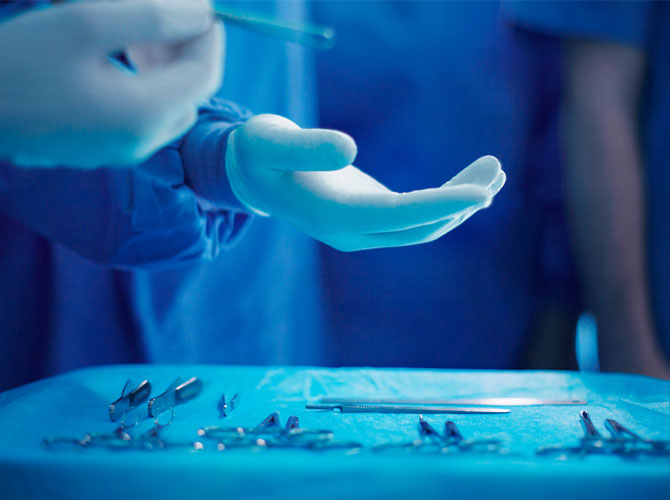
lumbar disc prolapse
A prolapsed lumbar disc is a spine condition that can cause lower back pain, numbness, tingling and muscle weakness in the lower body. This condition can also be called a herniated or ruptured disc, and usually is caused by normal, age-related deterioration. It can happen to people of all ages, but becomes more common after the age of 35.
If you suspect you have a prolapsed lumbar disc, you should schedule an appointment with your doctor to discuss prolapsed disc treatment options. Your doctor can properly diagnose your condition and help you find the right treatment for your specific needs. Prior to your appointment, take some time to learn about this condition and what causes it to develop.
How does a prolapsed disc develop?
A prolapsed lumbar disc can occur anywhere in the lumbar (lower) region of the spine, especially the vertebrae at the base. The discs between these relatively flexible lumbar vertebrae are prone to issues like prolapse because the lower back supports much of the body’s weight and facilitates a fairly wide range of motion.
As the body ages, the discs between our vertebrae begin to lose their elasticity and their ability to bounce back from everyday movements. This creates pressure which pushes the soft inner disc against the fibrous outer layer. Eventually, the disc wall can tear, and inner material pushes into the spinal column, resulting in a prolapsed disc. While the lower back is the most common area to find a prolapsed disc, a prolapsed cervical disc (upper spine) or a thoracic disc prolapse (middle spine) are also possible.
Symptoms and treatment for a prolapsed lumbar disc
While a disc prolapse in the lumbar spine goes undetected in many cases, it can occasionally produce symptoms that include:
- Numbness or tingling in the feet and toes
- Shooting pain into the hips
- Numbness or pain in the sole of the foot
- Weakness in the buttocks and upper leg
- Loss of ankle reflex
Prolapsed disc symptoms can be managed through conservative treatments like physical therapy, pain medications, exercise or rest. If prolapsed lumbar disc pain continues after weeks or months of this type of treatment, consider open spine surgery.
A prolapsed disc, also known as a herniated disc or slipped disc, occurs when a portion of a disc moves to a location where it shouldn’t be and the disc’s gel-like center leaks into the spinal canal through a tear. While the actual prolapse of the disc is not painful, symptoms such as pain, numbness, tingling and weakness can develop if the disc impacts a nerve root nearby in the spinal canal. In severe cases, bowel or bladder dysfunction may also occur, which requires immediate medical attention.
Many times, the symptoms caused by a prolapsed disc can be effectively treated through conservative therapies, which are nonsurgical treatments that aim to reduce pain by stretching and strengthening the spine in order to relieve the pressure on the damaged disc. These types of treatment include physical therapy, muscle relaxants, anti-inflammatories, low-impact exercises and chiropractic care.
Next steps after conservative treatment for a prolapsed disc
If you find that the conservative treatments mentioned above have not offered you any lasting pain relief, you may want to consider moving to a different treatment option. The first step is to consult Neurosurgeon about your concerns and continued pain. Many conservative therapies can be combined to increase your pain relief.
However, if several weeks or months of your new regimen also do not provide lasting relief, it may be time to consider a surgical treatment option. Before you determine if surgery is right for you, you must first research your surgical options and decide if you want to move forward with the procedure.
Surgical treatment for a prolapsed disc
Patients seeking surgical treatment for a prolapsed disc have the option to choose between traditional open back surgery or minimally invasive spine surgery. We strongly encourage you to research both options thoroughly before deciding on the procedure with which you would like to proceed. For instance, traditional open back surgery must be performed in a hospital setting to compensate for the highly invasive and high-risk nature of the procedure.
The surgery begins with a large 6- to 8-inch incision in the back, tearing through the muscles surrounding the spine. By cutting through these muscles, traditional open back surgery has more surgical blood loss and a higher risk of infection compared to other methods of surgery. Additionally, a patient’s recovery period must now be extended to allow time for the muscles to heal and rebuild themselves so they can help support the spine. Once the procedure is completed, patients are required to stay between two to five days in the hospital for monitored recovery.
Minimally invasive surgery is a safer and effective alternative to traditional open back surgery, offering less surgical blood loss and a reduced risk of infection. Unlike traditional open back surgery that uses highly invasive techniques, minimally invasive surgery is performed through a small incision that does not affect the surrounding muscles or soft tissue. Two types of minimally invasive surgery are done depending upon the disease nature— minimally invasive decompression and minimally invasive stabilization.
To treat a prolapsed disc, minimally invasive decompression surgery would remove a small portion of the broken disc to release pressure on the nerve root in the spinal canal. This is effective for moderate prolapsed discs. For more severe prolapsed discs, a minimally invasive stabilization surgery is done. During this procedure, the entire damaged disc is removed and replaced with an implant to relieve the pressure on the nerve root and stabilize the spine, thereby providing you with lasting relief from your symptoms.
